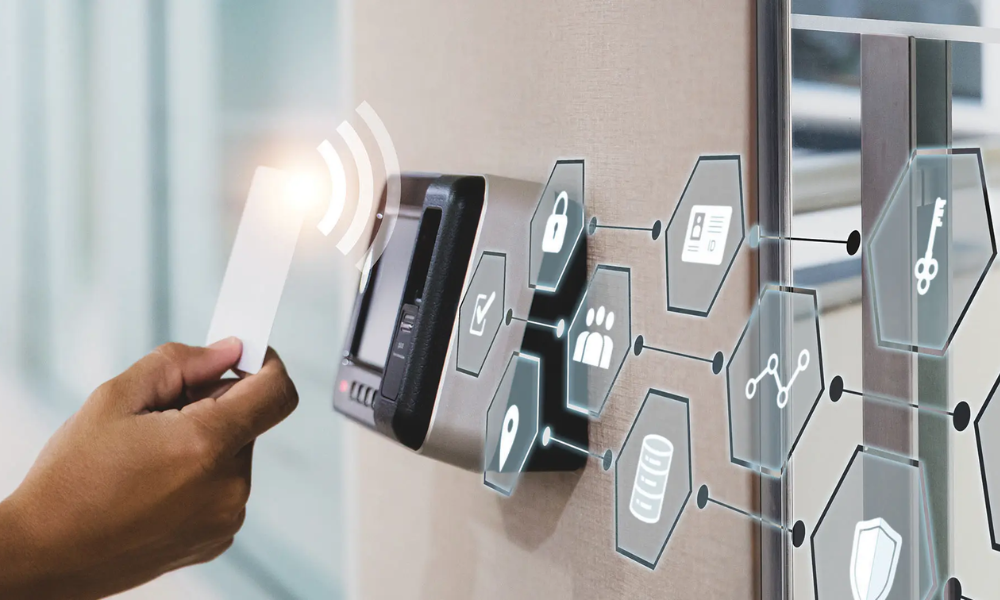Learn how Access Control Systems enhance security, streamline access, and protect your facility with expert insights from The Cook & Boardman Group.
Security and Access, Simplified.
In today’s evolving security landscape, safeguarding your valuable people, property, and assets is essential when managing a business. Access Control Systems (ACS) are a critical component of effective security strategies, offering advanced capabilities far beyond traditional locks and keys.
Modern ACS solutions are designed to deter unauthorized access, monitor activity, and enhance overall safety. In this guide, we’ll explore the fundamentals of access control systems, equipping you with the knowledge to make informed security decisions for your organization.
What Is an Access Control System?
An ACS is a type of security system that manages who can enter a facility and specific areas within it. The system functions by authenticating predefined credentials (e.g., access cards, PINs, biometrics, or mobile credentials) and granting or denying access based on what is provided. This ensures that only approved individuals can enter designated areas.
Key benefits of an access control system include enhanced protection for sensitive areas, easy management of access levels, and the flexibility to grow and adapt with your organization’s changing needs.
Components of an ACS
Access control systems rely on several key elements working together to enhance security:
- Access Points: Physical barriers where entry is controlled, such as doors, gates, and other entrances.
- Electrified Hardware: Devices that lock and unlock doors based on system signals.
- Credential Readers: Keypads or scanners for cards, biometrics, or mobile devices that verify identity to grant (or deny) access.
- Door Contact: A sensor that determines when an access point is opened or closed, and monitors for unauthorized access attempts.
- Exit Device/Request to Exit (REX): Sensors or buttons enabling authorized exits without compromising security.
- Control Panel: The “brain” of the system, processing data from readers and managing access permissions.
These system components work together to ensure seamless, secure access while providing detailed monitoring and reporting.
.png?width=757&height=426&name=FINAL%20ACS%20Components%20Infographic%20(1).png)
Types of Access Control Systems
The right ACS solution depends on your organization’s unique needs, including the type of facility, level of security required, and operational goals. Below are a few common options and their uses:
- Biometric Systems: Facial recognition, fingerprint, or iris scanning technologies serve as high-security options for guarding extremely sensitive areas.
-
- Example: A biomedical facility uses facial recognition to secure labs with hazardous materials, ensuring access only to qualified researchers.
- Keycard or Badge Systems: RFID or barcode technology on an access card. One of the most common and cost-effective options.
-
- Example: An airport uses keycards with role-based access levels, granting security personnel full access to restricted areas such as customs and immigration zones, while food court employees are limited to the hospitality or dining areas.
- Mobile Access Control: Smartphone-based systems for enhanced flexibility.
-
- Example: A co-working space allows clients to access rented meeting rooms through a smart device, enabling seamless access transitions based on reserved times.
- PIN-Based Access: Simple keypad solutions for secure, credential-free access.
-
- Example: A small business uses a PIN pad to secure their supply closet, providing a simple and cost-effective solution without the need for keycard management.
Each system type has its strengths, and a tailored approach ensures your ACS fits seamlessly into your operational framework. When considering an access control solution for your business, it’s important to consult with security professionals to ensure it aligns with your specific needs and future growth plans.
Best Practices for ACS Management
To maximize your investment, it’s important to not only choose the right system, but also implement proactive management practices that keep it running efficiently and securely. Proper oversight and regular updates ensure your access control system remains effective, aligns with your organization’s changing needs, and adapts to evolving security challenges. A few key best practices include:
- Identifying Vulnerabilities: Regularly check your system and facility for any gaps in security, like broken hardware or outdated settings, to make sure everything is working as it should.
- Setting Clear Permissions: Decide who should have access to specific areas and update those permissions as roles change. This ensures only the right people have access to the areas they need.
- Keeping Credentials Updated: Refresh access cards, PIN codes, or other credentials regularly. This simple step reduces the risk of security breaches from old credentials.
- Integrate Your Security Systems: Unify your access control system with other technologies, like cameras or alarms, to create a security setup that works together seamlessly.
Working with a team of security professionals can help you manage your system effectively, ensuring it’s always functioning as it should.
Choosing the Right ACS
A well-designed system should provide seamless, secure access to authorized personnel while reducing vulnerabilities. The effectiveness of your access control, and all electronic security solutions, depends on thoughtful implementation and management that aligns with your organization’s needs.
The Cook & Boardman Group takes a distinctive approach to safety solutions with our expertise in both doors, frames, and hardware and advanced security solutions. Our integrated approach ensures that your security infrastructure is robust, efficient, and future proof, helping you protect what matters most while optimizing resources.
Are your access points truly secure? Most security breaches happen due to outdated access control. See how modern solutions can protect your people, property, and peace of mind.





